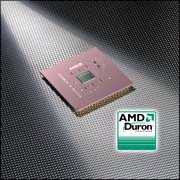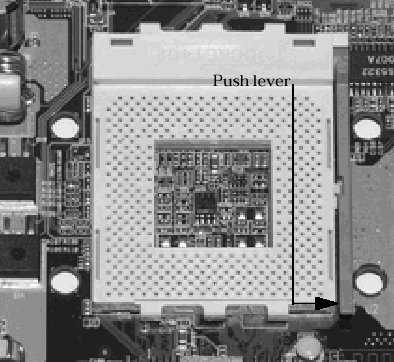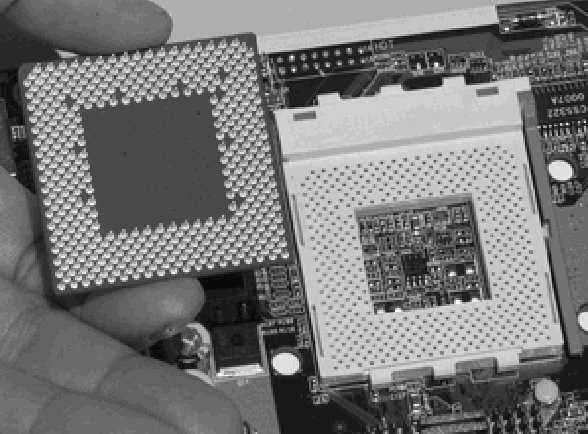AMD Duron
Review - if you're thinking of buying a budget system this Christmas, perhaps you should give the Celerons a miss and check this out..
- Advanced Micro Devices (AMD)Price - £65 for 750MHz part

Duronic
Up until now, if you were building a budget system there was only one option; Intel's Celeron processor. Running at speeds of 566 and 600MHz (and most recently 633, 667 and 700MHz), the chip loses a lot of performance due to having only half the L2 cache of its big brother the Pentium III, but as a result also has an extremely wallet-friendly price. Another contributing factor in the performance deficit is the frontside and memory bus speed of 66MHz. This causes a problem for any application that expects the CPU to process large amounts of data and transfer them back and forth in quick succession. Of course, one such example is a 3D game. So even if you're using a GeForce 2 GTS at 4x AGP, you're going to be limited to a very stunted memory throughput, and your framerate will be limited disastrously by the CPU; something no gamer wants. Obviously then the most important points in the construction of a competing budget chip are a higher frontside bus and memory bus, and enough cache to be safe but not to drag the price to stupid levels. This is where the construction process of the CPU becomes very important. With the Celeron, Intel takes Pentium IIIs that have a certain about of bad cache blocks during production and basically disables half of the cache. With the Duron, AMD use the same process as they do with the Thunderbird Athlons, giving them the same FSB and memory bus speed; 100MHz DDR, effectively three times that of the Celeron. The performance difference between the two is hefty, and to add insult to injury, not only is the Duron cheaper than the Celeron at corresponding frequencies, but it's also available at higher clock speeds anyway!

The Fundamentals
The Duron we're looking at is a 750MHz part, currently second only to the recently released 800MHz part. It's a 0.18micron core with some 25 million transistors, a multiplier of 7.5x, 128Kb of on-die L1 cache running at core speed, and 64-bit exclusive 64Kb of L2 cache running at clock speed. For details on the exclusive versus non-exclusive cache question, see our review of the Thunderbird. The packaging type is the now-familiar Socket A format, with 462 pins, similar to Intel's "flip-chip" format, and the processor uses a core voltage of 1.6V, although lower-speed Durons may use 1.5V. Interestingly, the Duron is only using Aluminium interconnects at the moment. This may have something to do with the fact that the high speed Copper interconnects are being reserved for chips of 1GHz and beyond. The chips are therefore being produced at AMD's Austin plant rather than its Dresden fab. As such the manufacturing process may need an update for the Duron to hit 1GHz, or at least a shift toward the Dresden fab. However, although the Duron is an impressive beast in itself and not just a "PIII reject" ala the Celeron, the question of its relative performance is still outstanding. Surely the only things standing between it and budget market domination are price, stability, performance and Intel's good name. AMD can't do much about the latter, but it looks as though the first three are in check.

Installation
The installation process went without a hitch. Our test board, an ASUS A7V, is one of the best in its class, and after the application of a thin layer of thermal paste and a GlobalWin FOP32 heatsink/fan we were all set. Although the A7V offers advanced options for memory tweaking, we felt it prudent to keep them at default settings so as not to influence the test. However if you are building a new PC and are stuck between the Celeron and Duron, this should be a concern, since the latest VIA chipset used here is asynchronous to a large extent, meaning that you can tweak memory performance without stressing the FSB in any way. Quite a feat, and something the BX chipset and even the i815 cannot yet do. Testing the chip wasn't too difficult; we pitted it against a Celeron running at 700MHz, a chip costing some £40 more than AMD's 750MHz part. You may think this is slightly unfair on Intel, but with the chip giant's prices looking as unshakable as ever we do not. As with the Thunderbird, as far as we're concerned, the most important test is its real-life performance in Quake III. This is what we care about, and a lot of gamers feel the same way. We used a fairly generic stick of 128Mb PC100 memory and a 3d Prophet II GeForce 2 GTS, with two boxes both running Windows Millenium on 7200RPM hard-drives. The first box featured the ASUS A7V and Duron 750MHz, with the second using an ABit SE6 and Celeron 700MHz.
Performance
: the low-end
: the other extreme
As the tests clearly show, at the low resolution, the Duron outperforms the Celeron by a long shot. At the highest resolution things aren't so clear-cut, but this has more to do with the graphics card limitations anyway. We found that at low resolutions, effectively the Duron 750 performs at the same level or thereabouts as the Athlon 700, whereas the Celeron has difficulty keeping up with a 500MHz processor or thereabouts.
Conclusions
If you're going to buy a budget processor with the intention of gaming with it, then you should buy a Duron. There are so many factors in its favour that it negates discussion. If you intend to use it for business work then there's a good argument for that too. Overall, the Duron pummels the Celeron into the ground. The only thing that can really save the Celeron now is the introduction of a 100MHz frontside bus, scheduled for the very near future. I feel we shall have to re-examine the issue then, however in the meantime, there is no argument.








